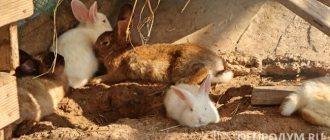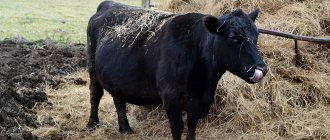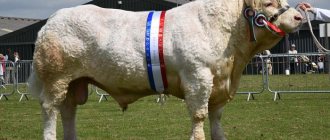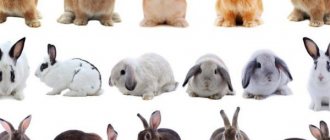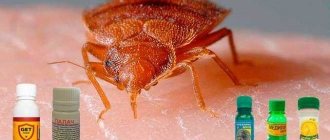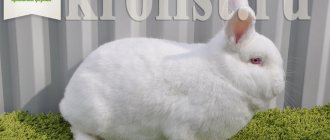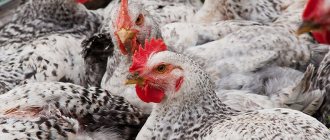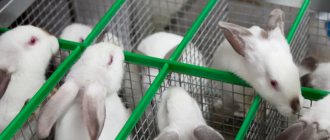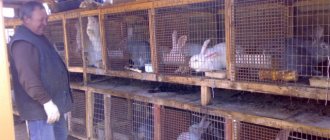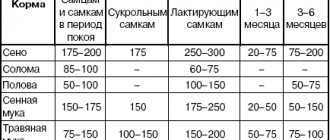Rabbit farming produces three types of main products. These are skins that at one time served as a source of additional income. Many rabbit breeders made them and sewed hats, mittens, made collars and even got the warmest sheepskin coats. In industry, spectacular fur coats, short fur coats and other types of popular items are sewn from rabbit skins. A less relevant area of rabbit breeding is down rabbit breeding. True, it must be admitted that downy rabbit breeding is slowly but surely being revived. Evidence of this is that more and more rabbit breeders are acquiring downy breeds of rabbits and... if only because they are beautiful. Of course, it’s like rabbit farming without meat rabbits – animals that provide healthy, dietary meat products.
Knowledge of the characteristics of the manifestation of productive qualities of animals is one of the conditions for effective rabbit breeding.
Rabbit meat yield
The yield of rabbit meat can be determined from the table depending on their breed, and also by using our calculator, where by entering the data you can immediately get the result.
The productivity of rabbits is assessed by slaughter weight (the weight of the rabbit carcass without skin, paws, head, internal organs, in addition to the kidneys) and by slaughter yield (the percentage ratio of slaughter weight to live weight before slaughter)
Proper and nutritious feeding of rabbits from an early age increases their meat productivity. When raising rabbits on complete granulated feed, the meat carcasses of the first category are obtained by 20% more compared to their peers raised on feed mixtures.
Slaughter yield of rabbit meat
Slaughter weight and slaughter yield increase with the age of rabbits.
| Rabbit breeds | Age, number of days | |||
| 65 | 110 | 135 | 270 | |
| White giant | 46,2 | 53,2 | 59,8 | 60,0 |
| Gray giant | 45,4 | 53,4 | 59,2 | 59,1 |
| Black-brown | 46,4 | 52,3 | 57,5 | 57,9 |
| Silver | 51,5 | 54,9 | 58,6 | 53,1 |
| Vienna blue | 50,8 | 53,4 | 56,6 | 61,2 |
| Soviet chinchilla | 49,8 | 51,5 | 55,2 | 59,2 |
You can calculate the meat yield of your rabbits using our form below (calculator)
Source
Down productivity
Down is obtained from live rabbits belonging to the downy breed. The consumer properties of rabbit down are better than those of sheep wool and downy fibers of Angora goats.
The downy covering of rabbits includes guard, intermediate and direct downy hairs (from 90%), which are longer and thinner than the hair of rabbits, from which meat and skins are obtained.
Down from rabbits is collected in the following ways:
- pinching is the most common method, as it allows you to obtain longer and more even fluff;
- a haircut;
- combing.
In the first case, the rabbit is placed on his knees, stuck together hair, if the animal has any, is pulled out, and the hair is combed from head to tail with a comb. The rabbit turns its head away from itself and holds its ears with its left hand; small strands are grabbed and pressed against it with the thumb of the right hand, first on the paws, then on the sides and then on the back. Due to careless movements, the rabbit's skin is damaged, and fluff will not grow on the wounds for a long time.
If a comb is not used during plucking, the strands are grabbed and pulled out using the thumb, index and middle fingers (a less practical method).
In winter, with a cage system outdoors (canopy, shed and other buildings), partial plucking of the fluff is recommended, without exposing the rabbits. Full plucking is justified in warm seasons and especially during molting. At the same time, the growing underfur remains untouched.
So that pregnant and lactating females do not worry, the fluff is removed from them twice:
- a few days before the mating company;
- after weaning the rabbits.
The fluff is trimmed using sharp scissors from the tail to the head. First, a parting is made along the ridge, then the hair is cut off, going down to the sides and stomach. With this method, the resulting hair is not equal in length, since it contains mature fluff and growing underfur. If the farm has adopted an outdoor cage system, rabbits are shorn in warm seasons.
Combing fluff is a weekly, one-time event. Less often, the fluff is combed out once every two weeks.
The result of the first collection is low-quality fluff. In addition, it weighs no more than 30 g. The maximum amount of fluffy hair occurs in the third or fourth collection.
Plucking is a stress factor for rabbits. To soften its effect, rabbits are plucked in two steps. First, the fluff is obtained from the back and, after the animal has rested, from the belly. In winter, it is recommended to take a 2-3 day break between procedures.
Pregnant females use their down as material for nests. It takes up to 40 g of down fiber to make one nest. Therefore, in some farms, in order to increase production yield, down is removed from nests: some at the beginning of the suckling period and completely after weaning the young animals.
One way to increase the productivity of rabbits is to regularly pluck their fluff. If you pluck it irregularly, it will grow to 8 cm and begin to fall out, fall off and become dirty.
Collection of shedding fiber is being considered as a backup method for increasing fluff yield. True, it leads to an increase in labor and time costs. In addition, such fluff is of low quality.
Timing for collecting fluff. The optimal time is when the down fiber is separated from the skin most easily, and its length is 6 cm or more. At the same time, it must be taken into account that excessive hair length negatively correlates with its quality.
The first fluff is removed (preferably with scissors, since pinching injures the delicate skin of the rabbits) when the young animals are 2 months old. The next time the fluff is removed (the best way is pinching) from animals that have reached 4-4.5 months of age. Starting from 6 months, the down is plucked monthly. Later they switch to the “adult” frequency of procedures.
When determining the optimal frequency of down removal, we are guided by the unevenness of its growth. Every month they work with areas of the animal’s body where the products have reached maturity. This approach, compared to the traditional, annual 4-6-fold removal of fluff, has a positive effect on the overall productivity of rabbits. High-quality fluff is obtained from the back, croup and hips, less valuable hair is found on the shoulder blades, neck, chest and abdomen. Hence the need to separate fibers of different quality.
Composition and energy value
This is a dietary product, so introducing dishes from it into the menu will not damage your figure and will help improve your health. The chemical composition of rabbit meat includes many components, including:
- proteins;
- 19 amino acids;
- manganese, fluorine, copper, iron, phosphorus;
- healthy fats;
- vitamins A, E, C, PP, B.
Despite the fact that other types of meat products have a similar composition, rabbit meat has a higher proportion of useful substances, and in terms of sulfur content it is recognized as a record holder. Thanks to the optimal composition of BJU, consumption of rabbit meat has a positive effect on the human body, strengthening the immune system and improving well-being.
The calorie content of rabbit meat is approximately 160–180 kcal per 100 g of product.
The exact energy value can only be determined if you know the age of the pet and the type of treatment, since the values may change:
- stewed rabbit contains 189 kcal;
- boiled fillet - 172 kcal;
- baked rabbit - 141 kcal;
- fried - 175 kcal.
Nutritional supplements for artificial weight gain
To improve appetite, breeders add vitamins to pet food. Beneficial substances of groups A and E are used together with fats, vitamin D is added to thick and porridge-like food. The drink is diluted with vitamin C.
After consultation with a veterinarian, animals are prescribed vitamin-mineral, as well as protein-vitamin-mineral supplements (PVMD).
They strengthen the animals’ bodies with useful microelements: manganese, calcium, phosphorus. Protein-containing options provide protein to the animal's muscles.
Vitamin and protein supplements have no contraindications. The correct dosage is calculated taking into account the body weight and age of the pet. The use of additives above the norm worsens the taste characteristics of rabbit meat.
Why it's useful
Meat products should be present in every person’s diet, especially when it comes to healthy and tasty rabbit meat. Rabbit meat brings the following benefits to the body:
- Strengthens nails, strengthens bone tissue and joints.
- Saturates brain cells with oxygen, improves brain activity.
- Speeds up metabolism.
- Reduces eye pressure, stabilizes glucose levels.
- Activates muscle growth.
- Restores strength after serious illness or physical exertion.
Doctors especially recommend consuming rabbit meat for those losing weight, athletes and older people, as the product contains the necessary range of vitamins, minerals and elements that will help get back in shape and improve health.
Record holders among long-eared animals
Ralph Rabbit's story is like a roller coaster. Paulina Grand's ward is considered the largest. But doctors are seriously concerned about the pet’s well-being. Today, the weight of the big-eared celebrity is 22 kg, although the owner assures that she provides the rabbit with physical exercise. However, the giant is outwardly active and does not show any dissatisfaction with its maintenance or care. The body length of the playful domestic hare is 130 cm.
Darius is another former Belgian breed record holder. In 2010, he even managed to dislodge Ralph, however, after that he lost ground with a weight of 19 kg. His owner, Annette Edwards, had previously registered large rabbits in the Book of Records; they were the parents of Darius. Apparently, the hereditary factor played a huge role in this particular case. The length of the body in 2010 was inferior to the current leader. True, according to some reports, the pet will soon snatch the palm from Ralph again. The owner claims that the rabbit gained weight - 22.2 kg and grew to 130 cm.
Jeff is the son of Darius, so it is not surprising that the whole world expects big victories from him. Annette, as a specialist in breeding ornamental breeds, is confident that Jeff will become a record holder. Now the rabbit is 3 years old, but its body length is already 95 cm. Miss Edwards is happy to tell the secret of such success in an interview. First of all, this is a balanced diet, as well as physical exercise. For example, Darius’s weight, as Annette admits, is largely determined by muscles. He is very active, runs constantly, and his caring owner spends the lion's share of her financial resources on quality maintenance. The price of good food for large breeds is high, which forces the farmer to turn to relatives for help.
How old is a dog by human standards?
Contraindications
Rabbit meat contains purines, which in excess can cause harm to the human body. The products can be consumed with caution and in limited quantities by people suffering from the following diseases:
- gout;
- arthritis;
- gallbladder dysfunction;
- psoriasis.
Dishes made from rabbit meat are not recommended for people with individual intolerance to the product, or for children suffering from neuro-arthritic diathesis.
Possible harm
Nutritionists and doctors agree that rabbit meat can only be harmful if abused. The product contains purines, which, when absorbed, activate the production of uric acid. If consumed in excess, a person may develop gout.
In order for the product to bring only benefits, doctors advise eating it no more than 5 times a week. The daily norm is:
- for women - 150 g;
- for children - 50–100 g;
- for men - 180 g.
Rabbit meat for children
Rabbit meat is useful not only for adults, but also for small children - it’s not for nothing that baby food manufacturers recommend this hearty and light product for complementary feeding. Rabbit meat is allowed to be given even to babies who have not yet turned one year old, because it does not contain fats that are dangerous for the child.
Rabbit meat is considered the best meat product for infants - it contains the necessary substances for the healthy development of the child.
In addition, meat contains vitamins and beneficial microelements that strengthen bone tissue and tooth enamel.
Where to get it?
Indeed, having found out all the benefits of rabbit meat, everyone will want to know where to get such a unique product for their table. Owners of rabbit farms are sure: you need to buy from them. In total, about two hundred species of animals are known, but not all are meat. Most of the known rabbits provide tasty meat and beautiful skins, but some are too small to be used for food.
The most delicious and healthy meat can be obtained from a meat breed. There are several of the most popular rabbits currently being bred on farms. They are the ones on sale.
Average weight of a rabbit after slaughter
Breeding rabbits is a profitable business that, with proper organization and proper care of the animals, brings a stable income. Keeping rabbits is beneficial because pets grow quickly and already at 2 months weigh 1.5 kg, and representatives of large breeds weigh an average of 2 kg. A rabbit carcass contains 85% meat. The older the rabbit, the more fat and calories the product contains.
You can determine the net yield of meat after slaughter by knowing the live weight of the animal - slaughter weight differs from it by about 30%. That is, if the rabbit weighed 4 kg, then after slaughter you can get 2.6–2.8 kg of clean meat products.
Gray giants
This breed of rabbits for breeding for meat belongs to the meat-skin breed. The animals are quite large, and their meat is rated as nutritious, tasty, and of high quality. The fertility of females is one of the reasons to choose this type of rabbit for your farm. On average, one litter produces 12 cubs. A distinctive feature is the high-quality feeding of the cubs by the female.
At a young age, gray giants grow quickly, fatten efficiently and in a short time. On average, the weight reaches 7 kg, and the animal reaches full maturity by the seventh month of life. The weight of a rabbit is about 3.5 kg; in well-fed individuals, the slaughter yield is up to 61%.
Meat yield table for rabbits of different breeds
The slaughter yield of rabbit meat depends on the breed and size of the animal, therefore early-ripening large varieties are chosen for breeding to obtain meat products. A table of rabbit meat yields from representatives of different pedigrees will help determine which breed is most profitable in this regard:
| Breed | Age (days) | ||
| 65 | 135 | 270 | |
| Meat yield in percent | |||
| White giant | 46 | 59,8 | 60 |
| Gray giant | 45,4 | 59 | 59 |
| Silver | 51,5 | 58,6 | 53 |
| Viennese | 50,8 | 56,6 | 61 |
| Chinchilla | 49,8 | 55 | 59 |
When to slaughter
If we talk about the timing of slaughter, then it all depends on the purpose of breeding animals. To obtain tender meat products, animals go under the knife as soon as they reach the desired weight. And if the goal is to obtain meat and good skin, then you need to take into account some points. It all depends on the time of molting. In case of untimely slaughter, the resulting skin products are of poor quality, and over time the skin will simply become bald.
To choose the most optimal slaughter time, you can use the following recommendations:
- young animals born in winter are slaughtered on day 120;
- In young animals born in summer, molting ends in November;
- after vaccinations, animals are sent to slaughter only a month later;
- most breeds are slaughtered when they reach a weight of 1.6 kg;
- The best time to score is from November to March.
How to select and store meat
Speaking about the beneficial properties of rabbit meat, it is important to note that they can be fully manifested only by consuming high-quality, fresh products. Of course, the best option to get a safe and environmentally friendly product is to raise rabbits yourself or buy carcasses from close friends and relatives. However, this option is not always possible, so before purchasing rabbit meat you should pay attention to the following details:
- Fresh rabbit meat has a delicate, pink color and has a dense structure , while the carcass of an older animal is an order of magnitude darker.
- An important feature that will help distinguish a fresh product from an old one is smell. Young rabbit meat has no aroma, but stale rabbit meat has the aroma of hay.
- Weight. When buying a carcass of a young rabbit, you should know that young animals weigh 1–1.5 kg , so a suspiciously large carcass should alert the buyer. A quality product has no cuts, weathered areas or visible stains.
- You should not take defrosted rabbit meat.
- Another check for freshness is the following method: lightly press the meat with your finger - in a fresh product, the indentation will quickly straighten out.
Farm
Video example
Let us immediately note that the accelerated rabbit is not some special breed, but just the result of growing technology. So, let's look at a small example for organizing a rabbit breeding farm.
First, a video about industrial rabbit breeding:
Production plan
Mikhailov’s methodology proposes the creation of mini-farms, the so-called “MIAKRO mini-farms”. It is installed on an area of approximately 1.4 square meters. m and about 13 rabbits are placed there, although this number, if desired, can be increased up to 30 animals.
Each year you will need 500 kg of feed per farm, as well as 250 kg of hay. One accelerator consumes up to 7 kg of hay and up to 14 kg of feed. If the capital turnover rate is 100 days, you can count on one rabbit weighing 4-6 kg and weighing one decade.
There can be different types of mini-farms, including two-tier ones, and you will have to determine their number yourself - it all depends on the capabilities of your site. If you have, for example, 16 pieces, then they will occupy an area of only one hundred square meters, produce a dozen rabbits a week and require weekly maintenance.
The remaining technical characteristics are as follows - 30-40 minutes of care if there are feeders with hay, an automatic drinker and a feeder with a gravity mechanism. If it gets cold outside and the temperature drops to +10 °C, then the energy consumption for heating will be 30 watts.
The main farm is located in St. Petersburg, where you can also order a training program, literature on the principles of raising giant rabbits and technical drawings of mini-farms. Help can also be provided at other farms - “Caligula” in Novosibirsk, UNPK “BelAKRO” in Belgorod.
Of course, good prospects for small business can open up when, in addition to the farm, you can create a processing workshop, sew outerwear from rabbit fur, and also produce your own vermicompost.
Farm totals
If we talk about benefits, then the final figures for the above example of a small farm will look something like this:
- production of a mini-farm – 5-20 thousand rubles;
- output of finished products – starting from 100 kg of rabbit meat, 55-60 skins;
- payback of the project – 6-8 months;
- with a farm of 300 mini-farms (minimum recommended effective size), expenses will be at the level of 350 thousand rubles. per year, and income is about 1.5 million rubles.
The price of a kilogram of a rabbit carcass is approximately 300-350 rubles. As a business, this activity is quite profitable.
Standard indicators
The weight of a live rabbit varies from 3.8 to 5.5 kg. There are rare exceptions to the rules. Farmers breed giant animals weighing up to 8-9 kg. The carcass of a killed rabbit is 25-30% smaller. Losses are the skin, the head, the entrails. Therefore, when slaughtering an individual weighing 5 kg, we get a carcass weighing no more than 3.5 kg.
Newborn rabbits weigh about 60 grams. In a month they increase 10-12 times. All this time they feed exclusively on mother's milk. And by 5 months the animal should already weigh at least 3 kg. Baby rabbits should gain about 60 grams per day.
Description
The characteristics of Californian rabbits consist of the genes of several species of progenitors used by breeders. The work involved Soviet chinchillas, Russian ermine rabbits, and the basis was the New Zealand white species. The taken ancestors were crossed with each other for several years - as a result, an exclusive was obtained that combines the best characteristics of the individuals. The resulting rabbits were distinguished by high-quality fur and high precocity.
Due to its rapid growth, the breed is often chosen for meat, and is also considered a broiler. Three-month-old females are allowed for mating, but the recommended age is 5 months. The animals are often kept as pets; in good conditions they live up to 10 years.
The California rabbit is prized for its calm and inquisitive nature. At the same time, in an unfamiliar environment, the animals test their curiosity; unlike other species, they are practically not subject to stress.
Appearance
The main distinguishing characteristic of Californian rabbits is the white color of their skin; only their ears, paws, and tail are black. At the same time, the black parts have clearly defined, smooth edges. Another mandatory distinguishing feature is the bright red color of the eyes. A popular subspecies called the "butterfly" looks similar. A distinctive feature of the latter is dark blue eyes, and the spot on the nose of the “butterflies” looks like an insect with open wings, which is why the subspecies is called that.
It is noteworthy that young Californian rabbits look normal, without pronounced breed characteristics. Spotting has not yet appeared, and the color is often lilac-bluish. The main indicator of Californians is good growth activity. Although they are not giants - their weight reaches five kg - they gain it after two months of life.
The constitution of individuals is strong, and the tendency to disease is average. Breed characteristics include short legs and a small head.
If there is a color violation or inelastic, sparse fur, this is considered a culling. Also considered illiquid are individuals that are too small or fat, with droopy long ears. Standard ears for purebred Californians should not exceed 10 cm, and they stand upright.
Character and habits
These features are individual for each animal. It is impossible to determine in advance what the purchased young stock will be like when they grow up. The main characteristic behavioral feature of all subspecies is gnawing. This can become a negative property when kept at home, since individuals indoors often damage wires, wallpaper, and other household items.
Individuals are generally independent and rarely go into the hands of a person, but decorative pets get used to it and even love to be in company
Individuals will definitely not accept intrusive attention, so you should not constantly try to catch the animal
According to the observations of the owners, rabbits are characterized by touchiness, especially if you hurt the animal: you stepped on it, carelessly injured it. Ignoring can be expressed by complete rejection of the person, as well as by marking the territory (they will pee on things, the bed)
Animals begin to mark their territory by the time they reach puberty. In this way they try to attract individuals of the opposite sex. If breeding is not part of the plan, it is better to spay or neuter domestic rabbits.
Table of average weight of different breeds by month
| Breed/age (given in months) | 1 | 3 | 5 | 7-8 |
| Flanders Belgian | 0,7 | 2,6 | 4,6 | 6,9-7,1 |
| Giant white | 0,6 | 2,3 | 3,7 | 5-5,1 |
| Butterfly | 0,550 | 2,4 | 3,5 | 4,2 |
| Giant blue royal | 0,5 | 2 | 3,3 | 4,3 |
| German giant | 1,1 | 4,750 | 7,1 | 8,9 |
| New Zealand | 0,5 | 2,5 | 3,5 | 4,150 |
| Californian | 0,4 | 2,7 | 3,5 | 4,150 |
| Silver | 0,4 | 2,2 | 3,650 | 4,9 |
| Black-brown | 0,6 | 2,5 | 3,550 | 4,8 |
| Gray giant | 0,5 | 2,2 | 3,6 | 4,8 |
| French ram | 1 | 2,6 | 4,3 | 5,5 |
| Soviet marder | 0,5 | 2,1 | 3,2 | 4,2 |
| Soviet chinchilla | 0,6 | 2,8 | 3,5 | 4,8 |
Effect on the growth of a rabbit's milk production
Favorable conditions for a high growth rate of animals are the high milk production of the female and her responsible attitude to the feeding process. The increased growth after such a push will continue even after the young are separated from their mother.
Rabbit milk is a high-calorie product containing all the necessary vitamins and minerals. Rabbits born in the summer will be provided with higher quality milk than with spring offspring. Milk production is somewhat reduced when birth occurs for the first time. The Californian breed and Soviet chinchillas have the best milk production indicators. Females with this indicator have a longer body and wider chest coverage.
What affects weight gain?
There are several parameters that affect sufficient weight gain in rabbits:
- Genetic predisposition.
- Proper nutrition. The diet should include various feeds, minerals, and vitamins.
- Feeding is organized 2-3 times a day.
- Access to drinking water. She must always be present.
- Use of food additives. With their help, you can promote rapid weight gain, as well as the formation of good immunity.
- The physical condition of rabbits depends on the level of comfort of their enclosures and proper care.
By choosing meat breeds and adhering to these rules, you can achieve excellent results in breeding rabbits.
Feeding
When industrially breeding meat rabbits, hay and special complete feed with a high protein content are used as the basis for animal nutrition, while providing free access to food and water.
At home, rabbits' diet is more varied. In the summer, they are given fresh grass: dandelion, nettle, plantain, alfalfa. In winter - hay, silage and grain (barley, oats, rye) in combination with mixed feed. Vegetables used include cabbage, fodder or sugar beets, carrots, potatoes (boiled or freshly peeled), and mineral and vitamin supplements are added if necessary.
Despite the fact that high-protein feeds can significantly increase the rate of weight gain due to an increase in muscle mass, it is not recommended to switch rabbits exclusively to such a diet and use only grain mixtures, since there are known cases of the extinction of entire populations.
Approximate daily ration for a fattening rabbit:
- grass – 700 g;
- feed or grain mixtures – 60-80 g;
- fresh vegetables, fruits – 150-200 g;
- hay – 150-200 g.
Belgian Flanders
This is a breed of giant rabbits, the distinctive features of which are an insatiable appetite and rich fluffy fur. However, despite their love for food, rabbits are extremely picky in their choice. On average, the weight of an individual reaches 12 kg, the body grows up to a meter in length, and the length of the ears is almost 20 cm.
Due to their impressive size, rabbits are considered profitable for farm breeding, as they produce a lot of meat. However, there are also weaknesses. For example, female rabbits produce offspring, although numerous, much later than many other varieties. The Belgian Flanders' coat comes in a variety of shades of gray. It is often used to imitate expensive fur.
New Zealanders
Many farmers also know how much a rabbit of this breed weighs - along with the Californian, the New Zealand rabbit is the most actively bred in our area. On average, live weight is up to 5 kg, the body length reaches half a meter. Distinctive features of the structure are a cylindrical compact body, a wide back, rich in meat. Particularly vigorous growth is observed at an early age. The females of this breed are very fertile and milk-producing; one litter gives the farmer up to 8 young rabbits.
Industrial rearing of the New Zealand breed of rabbit allows us to obtain meat of impeccable quality. The muscles are predominantly located near the spine, the ribs are rounded, and the shoulder blades are quite large. The muscle fibers on the lower back and sides are the most dense, although throughout the body the density is sufficient to indicate high quality. The yield per rabbit is up to 60%.
